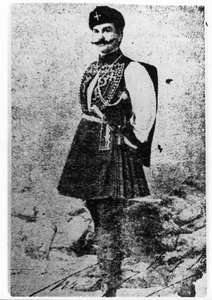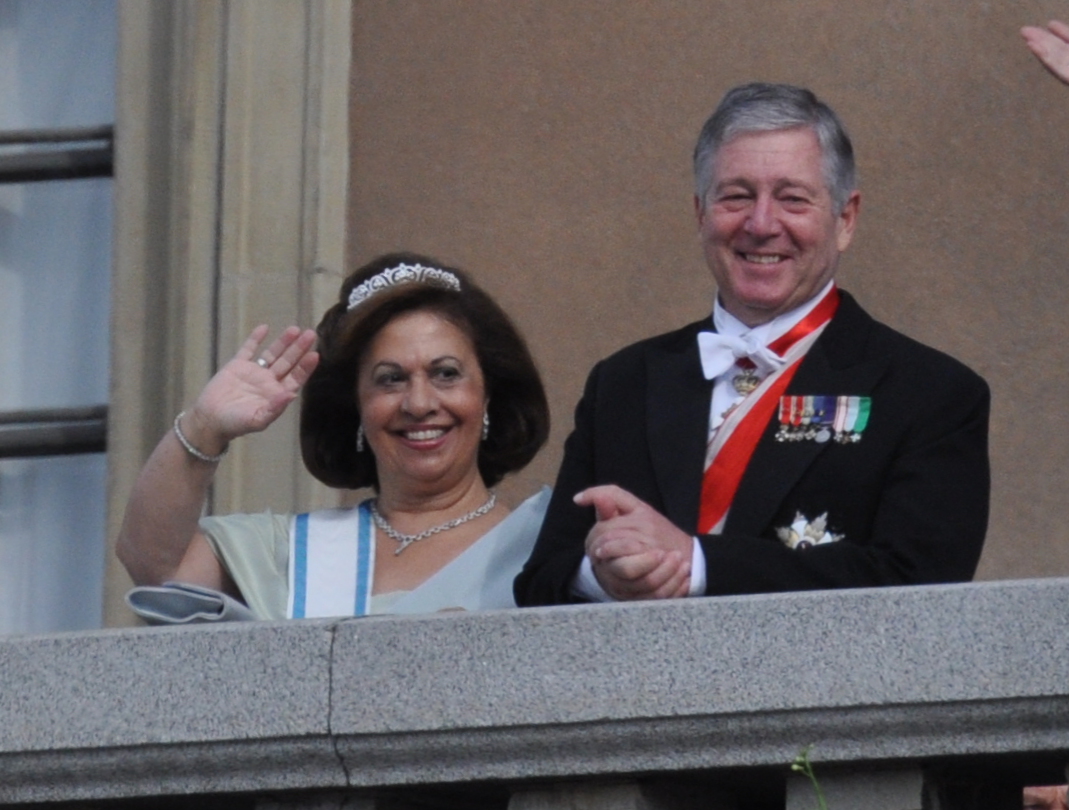|
Aspasia Manos
Princess Aspasia of Greece and Denmark (born Aspasia Manos el, Ασπασία Μάνου; 4 September 1896 – 7 August 1972) was a Greek aristocrat who became the wife of Alexander I, King of Greece. Due to the controversy over her marriage, she was styled Madame Manos instead of Queen Aspasia, until recognized as Princess Aspasia of Greece and Denmark after Alexander's death and the restoration of King Constantine I, on 10 September 1922. Daughter of Colonel Petros Manos, aide-de-camp of King Constantine I of Greece, and Maria Argyropoulos (Petros Manos and Maria Argyropoulos were both descendants of most prominent Greek Phanariote families of Constantinople and descendants of ruling Princes of Transylvania, Wallachia and Moldavia), Aspasia grew up close to the royal family. After the divorce of her parents, she was sent to study in France and Switzerland. She returned to Greece in 1915 and met Prince Alexander, to whom she became secretly engaged due to the expected ref ... [...More Info...] [...Related Items...] OR: [Wikipedia] [Google] [Baidu] |
Tatoi Palace
Tatoi ( el, Τατόι, ) was the summer palace and estate of the former Greek royal family. The area is a densely wooded southeast-facing slope of Mount Parnitha, and its ancient and current official name is Dekeleia. It is located from the city centre of Athens. Development of the estate and ownership disputes King George I of the Hellenes obtained the estate during the 1880s, purchasing it with private funds he had brought from Denmark. In 1916, during the First World War, the house was burned down. During the Republican regime in the 1920s, most of the estate was confiscated from its owners, but in 1936 it was returned to King George II of the Hellenes following the monarchy's restoration. During the Second World War, when the King was in exile and Greeks suffered considerable hardships under German occupation, the woods at Tatoi were chopped down for fuel and corpses were buried in shallow graves. King George II regained possession of the estate in 1946. It pas ... [...More Info...] [...Related Items...] OR: [Wikipedia] [Google] [Baidu] |
List Of Rulers Of Moldavia
This is a list of rulers of Moldavia, from the first mention of the medieval polity east of the Carpathians and until its disestablishment in 1862, when it united with Wallachia, the other Danubian Principality, to form the modern-day state of Romania. Notes Dynastic rule is hard to ascribe, given the loose traditional definition of the ruling family (on principle, princes were chosen from any branch, including a previous ruler's bastard sons – being defined as ''os de domn'' – "of domn marrow", or as having ''hereghie'' – "heredity" (from the Latin ''hereditas''); the institutions charged with the election, dominated by the boyars, had fluctuating degrees of influence). The system itself was challenged by usurpers, and became obsolete with the Phanariote epoch, when rulers were appointed by the Ottoman Sultans. Between 1821 and 1862, various systems combining election and appointment were put in practice. Moldavian rulers, like Wallachian and other Eastern European rule ... [...More Info...] [...Related Items...] OR: [Wikipedia] [Google] [Baidu] |
Alexander, Crown Prince Of Yugoslavia
Alexander, Crown Prince of Yugoslavia ( sr, Александар Карађорђевић, Престолонаследник Југославије; born 17 July 1945 in London), is the head of the House of Karađorđević, the former royal house of the defunct Kingdom of Yugoslavia and its predecessor the Kingdom of Serbia. Alexander is the only child of King Peter II and his wife, Princess Alexandra of Greece and Denmark. He held the position of crown prince in the Democratic Federal Yugoslavia for the first four-and-a-half months of his life, from his birth until the declaration of the Federal People's Republic of Yugoslavia later in 1945. In public he is also claiming the crowned royal title of "Alexander II Karađorđević" ( sr-Cyrl, Александар II Карађорђевић / ''Aleksandar II Karađorđević'') although the kingdom was abolished. Born and raised in the United Kingdom, he enjoys close relationships with his relatives in the British royal family. ... [...More Info...] [...Related Items...] OR: [Wikipedia] [Google] [Baidu] |
Peter II Of Yugoslavia
Peter II ( sr-Cyrl, Петар II Карађорђевић, Petar II Karađorđević; 6 September 1923 – 3 November 1970) was the last king of Yugoslavia, reigning from October 1934 until his deposition in November 1945. He was the last reigning member of the Karađorđević dynasty. The eldest child of King Alexander I and Maria of Romania, Peter acceded to the Yugoslav throne in 1934 at the age of 11 after his father was assassinated during a state visit to France. A regency was set up under his cousin Prince Paul. After Paul declared Yugoslavia's accession to the Tripartite Pact in late March 1941, a pro-British coup d'état deposed the regent and declared Peter of age. In response, Axis forces invaded Yugoslavia ten days later and quickly overran the country, forcing the king and his ministers into exile. A government-in-exile was set up in June 1941 following Peter's arrival at London. In March 1944, he married Princess Alexandra of Greece and Denmark. Their only s ... [...More Info...] [...Related Items...] OR: [Wikipedia] [Google] [Baidu] |
World War II
World War II or the Second World War, often abbreviated as WWII or WW2, was a world war that lasted from 1939 to 1945. It involved the vast majority of the world's countries—including all of the great powers—forming two opposing military alliances: the Allies and the Axis powers. World War II was a total war that directly involved more than 100 million personnel from more than 30 countries. The major participants in the war threw their entire economic, industrial, and scientific capabilities behind the war effort, blurring the distinction between civilian and military resources. Aircraft played a major role in the conflict, enabling the strategic bombing of population centres and deploying the only two nuclear weapons ever used in war. World War II was by far the deadliest conflict in human history; it resulted in 70 to 85 million fatalities, mostly among civilians. Tens of millions died due to genocides (including the Holocaust), starvation, ma ... [...More Info...] [...Related Items...] OR: [Wikipedia] [Google] [Baidu] |
Red Cross
The International Red Cross and Red Crescent Movement is a Humanitarianism, humanitarian movement with approximately 97 million Volunteering, volunteers, members and staff worldwide. It was founded to protect human life and health, to ensure respect for all human beings, and to prevent and alleviate human suffering. Within it there are three distinct organisations that are legally independent from each other, but are united within the movement through common basic principles, objectives, symbols, statutes and governing organisations. History Foundation Until the middle of the nineteenth century, there were no organized or well-established army nursing systems for casualties, nor safe or protected institutions, to accommodate and treat those who were wounded on the battlefield. A devout Calvinism, Calvinist, the Swiss businessman Jean-Henri Dunant traveled to Italy to meet then-French emperor Napoleon III in June 1859 with the intention of discussing difficulties in conducting ... [...More Info...] [...Related Items...] OR: [Wikipedia] [Google] [Baidu] |
Greco-Italian War
The Greco-Italian War (Greek language, Greek: Ελληνοϊταλικός Πόλεμος, ''Ellinoïtalikós Pólemos''), also called the Italo-Greek War, Italian Campaign in Greece, and the War of '40 in Greece, took place between the kingdoms of Fascist Italy (1922–1943), Italy and Kingdom of Greece, Greece from 28 October 1940 to 23 April 1941. This local war began the Balkans Campaign (World War II), Balkans Campaign of World War II between the Axis powers and the Allies of World War II, Allies and eventually turned into the Battle of Greece with Commonwealth of Nations, British and Nazi Germany, German involvement. On 10 June 1940, Italy declared war on France and the United Kingdom. By September 1940, the Italians had Italian invasion of France, invaded France, Italian conquest of British Somaliland, British Somaliland and Italian invasion of Egypt, Egypt. This was followed by a hostile press campaign in Italy against Greece, accused of being a British ally. A number of ... [...More Info...] [...Related Items...] OR: [Wikipedia] [Google] [Baidu] |
United Kingdom
The United Kingdom of Great Britain and Northern Ireland, commonly known as the United Kingdom (UK) or Britain, is a country in Europe, off the north-western coast of the continental mainland. It comprises England, Scotland, Wales and Northern Ireland. The United Kingdom includes the island of Great Britain, the north-eastern part of the island of Ireland, and many smaller islands within the British Isles. Northern Ireland shares a land border with the Republic of Ireland; otherwise, the United Kingdom is surrounded by the Atlantic Ocean, the North Sea, the English Channel, the Celtic Sea and the Irish Sea. The total area of the United Kingdom is , with an estimated 2020 population of more than 67 million people. The United Kingdom has evolved from a series of annexations, unions and separations of constituent countries over several hundred years. The Treaty of Union between the Kingdom of England (which included Wales, annexed in 1542) and the Kingdom of Scotland in 170 ... [...More Info...] [...Related Items...] OR: [Wikipedia] [Google] [Baidu] |
Elisabeth Of Romania
Elisabeth of Romania (full name ''Elisabeth Charlotte Josephine Alexandra Victoria'': ro, Elisabeta a României, el, Ελισάβετ της Ρουμανίας; 12 October 1894 – 14 November 1956) was a princess of Romania and member of the House of Hohenzollern-Sigmaringen and by marriage Queen of Greece during 1922–1924. Raised by her grand-uncle King Carol I of Romania and his wife Queen Elisabeth, she was an introvert and socially isolated. Married to Prince George, the heir to the Greek throne in 1921, she felt no passion for him and underwent the political turmoil in her adopted country after World War I. When her husband became king of Greece in 1922 as King George II, Elisabeth was involved in assisting refugees who arrived to Athens after the disaster of the Greco-Turkish War. The rise of the revolutionary climate, however, affected her health and with great relief she left the Kingdom of Greece with her husband in December 1923. The royal couple then settle ... [...More Info...] [...Related Items...] OR: [Wikipedia] [Google] [Baidu] |
George II Of Greece
George II ( el, Γεώργιος Βʹ, ''Geórgios II''; 19 July Old_Style_and_New_Style_dates">O.S.:_7_July.html" ;"title="Old_Style_and_New_Style_dates.html" ;"title="nowiki/>O.S.:_7_July">Old_Style_and_New_Style_dates.html"_;"title="nowiki/>Old_Style_and_New_Style_dates">O.S.:_7_July1890_–_1_April_1947)_was_O.S.:_7_July">Old_Style_and_New_Style_dates.html"_;"title="nowiki/>Old_Style_and_New_Style_dates">O.S.:_7_July1890_–_1_April_1947)_was_List_of_kings_of_Greece">King_of_Greece_from_September_1922_to_March_1924_and_from_November_1935_to_his_death_in_April_1947. The_eldest_son_of_King_Constantine_I_of_Greece.html" "title="List_of_kings_of_Greece.html" "title="Old Style and New Style dates">O.S.: 7 July">Old_Style_and_New_Style_dates.html" ;"title="nowiki/>Old Style and New Style dates">O.S.: 7 July1890 – 1 April 1947) was List of kings of Greece">King of Greece from September 1922 to March 1924 and from November 1935 to his death in April 1947. The eldest son of Kin ... [...More Info...] [...Related Items...] OR: [Wikipedia] [Google] [Baidu] |
Ottoman Empire
The Ottoman Empire, * ; is an archaic version. The definite article forms and were synonymous * and el, Оθωμανική Αυτοκρατορία, Othōmanikē Avtokratoria, label=none * info page on book at Martin Luther University) // CITED: p. 36 (PDF p. 38/338) also known as the Turkish Empire, was an empire that controlled much of Southeast Europe, Western Asia, and Northern Africa between the 14th and early 20th centuries. It was founded at the end of the 13th century in northwestern Anatolia in the town of Söğüt (modern-day Bilecik Province) by the Turkoman tribal leader Osman I. After 1354, the Ottomans crossed into Europe and, with the conquest of the Balkans, the Ottoman beylik was transformed into a transcontinental empire. The Ottomans ended the Byzantine Empire with the conquest of Constantinople in 1453 by Mehmed the Conqueror. Under the reign of Suleiman the Magnificent, the Ottoman Empire marked the peak of its power and prosperity, as well a ... [...More Info...] [...Related Items...] OR: [Wikipedia] [Google] [Baidu] |
Eleftherios Venizelos
Eleftherios Kyriakou Venizelos ( el, Ελευθέριος Κυριάκου Βενιζέλος, translit=Elefthérios Kyriákou Venizélos, ; – 18 March 1936) was a Greek statesman and a prominent leader of the Greek national liberation movement. He is noted for his contribution to the expansion of Greece and promotion of liberal-democratic policies.Kitromilides, 2006, p. 178"Liberty Still Rules" '''', 18 February 1924. As leader of the , he held office as |








